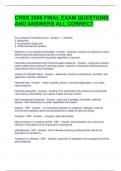CRSS 3500 FINAL EXAM QUESTIONS
AND ANSWERS ALL CORRECT
Four phases of herbicide action - Answer- 1. retention
2. absoprtion
3. movement to target site
4. inhibit biochemical reaction
Selective vs non-selective herbicides - Answer- -selective: controls one species of plant
without seriously affecting the growth of another plant
-non selective: controls all living plants regardless of species
herbicides characteristics that influence weed resistance - Answer- -single site of action,
used multiple times during the growing season, used for consecutive growing seasons,
used without other control strategies
causes of herbicide failure - Answer- -weed size, moisture, temperature, humidity, rate,
application method, calibration
herbicide fate - Answer- - water solubility, portion, microbial degradation, ionic state,
vapor pressure
herbicide adsorption - Answer- -binding of an herbicide to the surface of a soil particle
-soil texture, permeability, soil organic matter and clay content
best management practices - Answer- -spot treat if possible, flow label, calibrate
sprayer, train employees on proper application techniques
disease - DEF - Answer- - an interaction between an organism, pathogen, and the
environment leading to abnormal development or death of cells and tissue
symptom - DEF - Answer- - change in plant phenotype
latency period or incubation period - DEF - Answer- period between the moment of
infection of the plant and the expression of symptoms
pathogenesis - DEF - Answer- all the disease-inducing processes that lead to the
expression of symptoms
incidence of a disease - DEF - Answer- proportion of diseased units compared to all the
parts analyzed
, severity of disease - DEF - Answer- quantitative assessment of the degree of attack (%
of the leaf area attacked)
virulence - DEF - Answer- capacity of pathogens to overcome plant resistant genes;
linked to the presence or absence of R-genes (if it can infect the plant, the more plant is
can infect the higher the virulence
agressiveness - DEF - Answer- the quantitative component of pathogenicity;
quantitative traits of the pathogen life cycle such as infections efficiency, latent period,
sporulation rate, infection period, lesion size, etc.
disease triangle - Answer- -pathogen: fungi, bacteria, viruses, nematodes
-host: plant out of place, stressed plant, too wet/dry
-environment: fertility, leaf wetness, compact soils, temperature, air circulation
spore-forming fungi - Answer- -Spores are microscopic seed like structures that function
in dissemination and survival of fungi
-EX: pythium blight, copper spot, anthracnose, powdery mildew, gray leaf spot
nonspore-forming fungi - Answer- - As the name implies, nonspore- forming fungi are
species of fungi that do not form spores or seldom form spores
- Some species only form hyphae and other species produce both hyphae and sclerotia
-EX: dollar spot, brown patch, large patch, pink patch
disease resistance - DEF - Answer- - a genetically controlled, physiological response of
a host plant to a pathogen that limits disease severity or incidence
vertical vs horizontal resistance - Answer- - vertical: a cultivar with a vertical resistance
gene shows high resistance to some race and lower resistance to others
-horizontal: a cultivar with horizontal resistance shows an intermediate level of
resistance to all races of the pathogen
Nitrogen and diseases - Answer- - most information on the effects of nutrition on
disease deals with nitrogen
- nitrogen can also enhance certain diseases (pythium blight, spring dead spot, brown
patch) AND suppresses other diseases (dollar spot, anthracnose)
environmental manipulation for diseases - EX - Answer- -reducing shade, increasing air
circulation, increasing soil pH, reducing compaction, regular aeration, watering
infrequently and deeply
Fungicide - DEF - Answer- -any chemical that kills a fungus
1. Trade name
2. Common name
3. Chemical name




